Read Reviews
The Best Oscillating Multi Tools
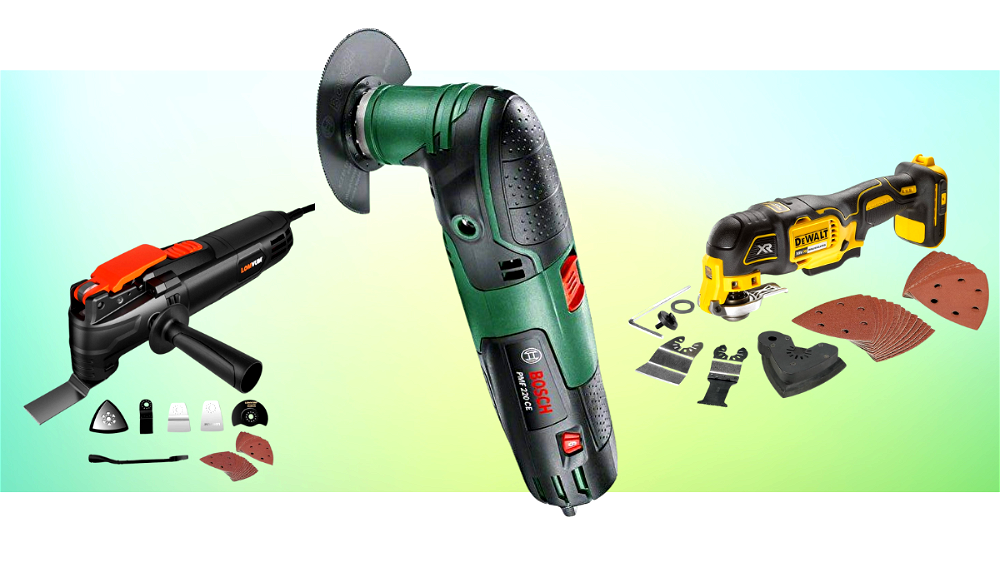
-
Best brushless multi tool for professionals - DeWalt DCS355N-XJ 18V Brushless Oscillating Multi-Tool
-
Best corded multi tool option - Bosch PMF 220 CE Corded Oscillating Multi Tool
-
Best corded multi tool - DeWalt DWE315KT Corded Oscillating Multi-Tool
-
Best budget corded multi tool - Worx WX686.1 Sonicrafter Corded Oscillating Multi Tool
-
Best cordless with adjustable chuck - Makita DTM50Z Cordless Oscillating Multi Tool
-
Best corded multitool option - Makita TM3010CK Corded Oscillating Multi Tool
-
Best budget cordless multitool - Einhell Cordless Multifunctional Tool TC-MG 18 Li-Solo
-
Best value tool-free multi tool - Lomvum 300W Multi-Oscillating Tool
-
Best multitool for power - Draper 20987 230V Oscillating Multi-Tool
Oscillating Multi Tool Reviews
1. DeWalt DCS355N-XJ 18V Brushless Oscillating Multi-Tool [ SAVE 19% ]
Best brushless multi tool for professionals
- As you’d expect from a quality DeWalt tool, the grip is excellent. It’s ergonomic and well balanced, even with a high Ah battery attached.
- The quick release system saves time and effort. You don’t need to fiddle around with spanners, and the blades feel incredibly secure.
- The trigger is huge. It’s also got a nice shape to it so you can use it at any angle with any finger. It can be pressed in both directions like a rocker switch for ultimate versatility.
- You can lock the trigger off with your thumb for constant speed when you need it.
- You don’t normally get a bare tool with a huge accessory pack. The blades and sanding pads are top quality and will get you going straight away.
- This is a professional level cordless multi tool. There are much cheaper tools on my list. Unless you need to use one every day for precision jobs, save your money.
- Some users seemed to get confused by the accessory pack. Out of the 29 pieces you get, 26 are sanding pads.
- Don’t forget this is a bare tool. It comes without a battery, charge or case.
- Type
- Cordless, Brushless
- Power
- Battery - 18V (Bare)
- Oscillating Speed
- 0-22,000opm
- Tool-free Change
- Yes
- LED
- Yes
- Blades
- 3
- Sandpaper Sheets
- 25
- Weight
- 1.1kg
- Build Quality
- 5
- Performance
- 5
- Ease of Use
- 5
- Value for Money
- 4
One of the best cordless multi tools I’ve tested is the DeWalt DCS355N-XJ. It’s got an incredible brushless motor, it’s ridiculously well built, and the quick-release system is simple to use.
DeWalt are one of those brands that professional builders and savvy DIYers like. They make robust and powerful tools that share the same family of batteries. It means you can power up your saw, drill and sander with just one set of XR batteries.
Weighing in at just 1.1 kg, you’d be surprised to know that this Dewalt tool is capable of 0 – 20,000 opm – more than enough power for the toughest jobs. And this variable speed range is controlled by the large trigger.
I think this is the best oscillating multi tool for professionals because you can change speeds on the fly without fiddling with a speed selection wheel. And the LED light means you can use this cordless multi tool in the tightest gaps without searching for a torch.
Included with the multi tool accessories are two blades – one for wood and one for metal cutting – and a scraper attachment. You even get a selection of quality hook and loop sanding pads thrown in with the sanding shoe. As a “bare” tool, there are no batteries included, and you’ll have to source a carry case separately as well.
Did you find this review helpful?
2. Bosch PMF 220 CE Corded Oscillating Multi Tool [ SAVE 24% ]
Best corded multi tool option
- An auxiliary handle on a multi tool is seriously handy. It’s ideal for when you need a bit more steadiness or have a big sanding job in front of you.
- Fitting blades with the AutoClic system is a cinch. You don’t need any tools and it can be done in seconds.
- The blow moulded case is extremely sturdy and should keep everything safe for years.
- Another corded multi tool with a powerful LED light is a good thing to see.
- You can’t use any old blades with this multi tool. You’re locked into buying Bosch Starlock Plus.
- The lack of variable speed control is annoying. It limits the control you have over a lot of tasks.
- Seeing as this multi tool uses proprietary blades, it would be nice if more were supplied in the kit.
- Type
- Corded
- Power
- Mains - 220W
- Oscillating Speed
- 15,000-20,000opm
- Tool-free Change
- Yes
- LED
- Yes
- Blades
- 1
- Sandpaper Sheets
- 6
- Weight
- 1.1kg
- Build Quality
- 4
- Performance
- 4
- Ease of Use
- 4
- Value for Money
- 3
This is the Bosch PMF 220 CE Corded Oscillating Multi Tool. This model is one of Bosch’s best multi tools in the “green” line of its DIY level tools.
Weighing 1.1 kg, this oscillating tool is solidly built yet easy to handle and is at home cutting or grinding resilient materials.
This Bosch multi tool comes with an auxiliary handle that can be fitted to either side of it. This makes it steadier to control and absorbs more vibration when faced with those longer jobs. A soft start and variable speed setting with 6 speeds control the oscillation rate (max 20,000 opm).
Multi tool accessories attach to the tool head using Bosch’s tool-less AutoClic system. You simply pull the lever to release one accessory and push and click to attach a new one. It’s easy to use but be warned that the AutoClic system only works with Starlock accessories. The Starlock mounting interface is a newer version of Bosch’s OIS (oscillating interface system) that other major brands of oscillating multi-tool use, so you need to use Starlock-compatible accessories.
This Bosch multi tool comes with a handy four-step depth stop to ensure you don’t overdo your plunge cuts, and a strong carry case. If you don’t want to compromise on quality and seek the best oscillating multi tool for the UK market, then this is well worth the money!
Did you find this review helpful?
3. DeWalt DWE315KT Corded Oscillating Multi-Tool [ SAVE 4% ]
Best corded multi tool
- Unless you really need to go cordless, this is the ultimate oscillating multi tool. Featuring virtually the same stats compared with the DeWalt DCS355N-XJ, it’s cheaper and comes with more accessories.
- The DeWalt T-STAK cases are some of the best boxes in the business. They’re truly tough and you can stack them high. Worth the price alone if you ask me!
- It often annoys me that corded power tools lack a decent LED light. This isn’t the case here. The DWE315KT light is bright and ideal for working in tight spaces.
- The included depth stop is one of my most used accessories on a multi tool. Avoid plunging too far through plasterboard or any other material easily.
- You can easily connect the multi tool up to a dust extraction system.
- Several users have complained that the included blades don’t last long enough.
- The trigger shape means you might accidentally turn on the tool when you put it down.
- You need to be careful when using the sanding pads at high speed. If they overheat, the hook and loop backing will melt.
- Type
- Corded
- Power
- Mains - 300W
- Oscillating Speed
- 0-22,000opm
- Tool-free Change
- Yes
- LED
- Yes
- Blades
- 7
- Sandpaper Sheets
- 25
- Weight
- 1.5kg
- Build Quality
- 5
- Performance
- 5
- Ease of Use
- 5
- Value for Money
- 3
If DeWalt is your preferred brand and cost is more important to you than going cordless, you need to check out the DeWalt DWE315KT.
Taking the cost of batteries and charger into account, the DWE315KT sells for close to half the price of one of the best cordless multi tools, the DeWalt DCS355D2 XR!
And like the Makita TM3010CK, this is a high quality corded oscillating multi tool. It boasts a powerful 300 Watt motor that delivers up to 22,000 oscillations per minute (opm).
This DeWalt multi tool is comfortable to hold and control with what DeWalt describe as “Superior Ergonomics”. It’s enhanced with a large lock-on / lock-off trigger for managing its variable speed control. A tool-free quick release accessory key replaces a hex wrench for securing accessories. And the universal blade adaptor accepts cutting accessories from non-DeWalt brands.
An LED light and dust extraction port are a handy extra when sanding, and this oscillating tool comes with a long cord. It’s all packed up in a robust stackable case with a selection of multi tool accessories, including a seriously useful depth stop.
If you are searching for the best multi tool around, you should seriously consider adding the DWE315KT to your tool box.
Did you find this review helpful?
4. Worx WX686.1 Sonicrafter Corded Oscillating Multi Tool[ SAVE 7% ]
Best budget corded multi tool
- This is one of the lightest multi tools I’ve tried out so far. It’s nicely balanced and easy to work with above head height.
- You get a decent range of multi tool accessories thrown in. There are 15 different blades and sanding pads to choose from.
- The case itself feels nice and sturdy. The handle is made from metal and feels like it’s built to last.
- The overall build quality is good. The oscillating tool is robust and well put together.
- It might look like the WX686 has a quick blade change lever system, but it’s not. The “lever” is a hex key for changing the blades. And it’s made of plastic too.
- Some users have noticed that the vibrations can shake the hex lever loose unless you hold onto it.
- The opm range of 11,000 – 20,000 isn’t impressive compared to the hugely capable DeWalt DCS355N-XJ. 11,000 opm is fast for a lowest setting.
- The lack of an LED light is annoying. For a power tool designed to get into tight spots, you’d think it was an essential accessory.
- The 250 Watt motor isn’t powerful in comparison with the Makita TM3010CK’s big 320 Watt beast.
- Type
- Corded
- Power
- Mains - 250W
- Oscillating Speed
- 11,000-20,000opm
- Tool-free Change
- No
- LED
- No
- Blades
- 4
- Sandpaper Sheets
- 15
- Weight
- 1.45kg
- Build Quality
- 4
- Performance
- 4
- Ease of Use
- 4
- Value for Money
- 5
The WORX WX686.1 Sonicrafter Corded Oscillating Multi Tool provides serious competition for the best oscillating multitools from Makita, DeWalt, Bosch and the like.
This is a well-engineered versatile power tool with a 250 Watt motor and an aluminium gearbox, yet it weighs just 1.45 kg. This combination gives this oscillating tool a better power-to-weight ratio than many of its competitors. Alongside this is the dual grip soft handle that ergonomically enhances handling and control.
A lighter-weight power tool often means power is compromised. But that is definitely not the case with this Worx multi tool. Oscillation rates ranging from 11,000 to 20,000 opm are controlled by a variable speed dial with 6 speed settings. You simply select the appropriate speed depending on the multi tool accessory and application. Constant speed control is also available for longer and more tiring tasks.
The WX686.1 Sonicrafter features a Universal Fit clamping system that ensures that accessories never dislodge during use. This means you have a huge choice of aftermarket accessories available that are compatible with this oscillating tool. It comes with a nice long lead and a durable carry case as well.
Did you find this review helpful?
5. Makita DTM50Z Cordless Oscillating Multi Tool
Best cordless with adjustable chuck
- The 3.2 degrees of oscillation is literally double what the DeWalt DCS355N-XJ puts out. It’s really no comparison in terms of cutting ability.
- The anti-restart safety feature is essential. If you run out of power with the tool switched on, it won’t jump into life with a fresh battery. You must switch it on and off again. This is bound to prevent nasty accidents.
- I like the soft start motor. For a power tool that creates a lot of (necessary) vibration, you can switch it on to maximum opm without a problem.
- A powerful LED light is essential for most indoor jobs that require a multi tool. This one is the business, it’s bright and casts a wide beam.
- Cordless multi tools function more efficiently with brushless motors. Brushed ones drain more battery power compared to the DeWalt DCS355N-XJ’s brushless motor, for example.
- At 1.8 kg, this multi tool is on the heavy side. Once you start adding high Ah batteries, it’s a bit of a beast.
- Compared to the extensive 29 piece accessory kit supplied with the DeWalt DCS355N-XJ, this feels a bit stingy. When Makita says “naked”, they mean it!
- It’s not the fastest oscillating multi tool I’ve tested out. 20,000 opm isn’t much when you compare it with the Einhell TC-MG’s massive 40,000 opm.
- Type
- Cordless
- Power
- Battery - 18V (Bare)
- Oscillating Speed
- 6,000-20,000opm
- Tool-free Change
- No
- LED
- Yes
- Blades
- 0
- Sandpaper Sheets
- 0
- Weight
- 1.8kg
- Build Quality
- 5
- Performance
- 5
- Ease of Use
- 4
- Value for Money
- 4
You want a quality cordless multi tool, but you’re unsure about how much hard-earned cash to commit? In steps Makita with this great option – buy it as a bare tool at a really competitive price!
You’ll need at least one battery and a charger, but if you’ve already bought into Makita’s battery-powered tool range that won’t be a problem. And if you haven’t already, you have complete freedom to choose whatever battery, charger, and range of accessories you want. You’ll be ahead of the game price-wise, and you will have a quality oscillating multi tool.
This Makita multi tool is incredibly versatile. Its rotating head can swivel through 360 degrees with 12 stops at 30 degrees apart, so pretty much any nook or cranny is in reach. Plus, its Oscillating Interface System (OIS) accommodates accessories (secured using a hex wrench) from both Makita and other brands.
The Makita DTM50Z Cordless Multi Tool is a little heavier than some of its competitors at 2.2 kg with a 2 Ah battery, but the solid build does mean it vibrates less. It also has a soft-start and variable speed control to manage the 6,000 – 20,000 opm. Overload protection cuts in if the motor gets too hot. The power switch sits conveniently under your thumb and there is an anti-restart function to prevent accidental starting.
Did you find this review helpful?
6. Makita TM3010CK Corded Oscillating Multi Tool
Best corded multitool option
- Considering this is a quality Makita tool, it’s a bit of a bargain. You get excellent performance and build quality for less than the equivalent Bosch or Makita multi tool.
- Compared to some multi tools, the TM3010CK runs quiet. 82 dB is low and ideal for long sessions.
- The quick release system is solid but easy to get the hang of. You can use almost any type of blade fitting system as well.
- This oscillating tool comes with a nice long cable. If you’re going to use a corded tool, it’s essential!
- I’ve always been a fan of Makita’s blow moulded cases. They’re strong and there’s always room to spare for bits and pieces.
- The TM3010CK suffers from the same problem that a lot of corded multi tools have. There’s no work light! It really could do with one for those fiddly jobs.
- For a corded tool, I’d like to see a higher maximum opm than 20,000. The 320 Watt motor is more than capable.
- Just like the Makita DTM50Z, you don’t get any accessories include in the purchase price. The case is great, but I’d like to see a couple of blades to get started.
- Type
- Corded
- Power
- Mains - 320W
- Oscillating Speed
- 6,000-20,000opm
- Tool-free Change
- Yes
- LED
- No
- Blades
- 0
- Sandpaper Sheets
- 0
- Weight
- 1.6kg
- Build Quality
- 5
- Performance
- 5
- Ease of Use
- 4
- Value for Money
- 4
If you don’t need a cordless oscillating multitool then you need to check out the Makita TM3010CK Corded Oscillating Multi Tool. It’s one of the best oscillating multi tools I’ve tried out so far.
The build quality of this oscillating tool is plain to see and what you’d expect from a brand like Makita. Weighing 1.6 kg, it is a little heavier than some other corded oscillating multi tools, but it feels perfectly balanced. It’s easy to hold and control with its sturdy barrel grip.
The 320 Watt motor generates more than enough power for demanding multi tool tasks, and with noticeably reduced noise and vibration levels compared to other oscillating tools. I like the soft start, variable speed control and thumb-activated constant speed lock-on / lock-off trigger. They mean you have all the control you need to manage the 6,000 – 20,000 oscillation rate.
Like its cordless Makita DTM50Z cousin, this Makita multi tool has a 360 degree rotating head with 12 incremental stops and an (OIS) interface that can accept non-Makita branded accessories. My favourite upgrade though- the accessories are attached using a more convenient tool-less quick-release lever and clamp. It also comes with a nice long lead and a sturdy Makita carry case.
Did you find this review helpful?
7. Einhell Cordless Multifunctional Tool TC-MG 18 Li-Solo
Best budget cordless multitool
- An affordable cordless multi tool. If you’re on a budget, you don’t always need to stay corded!
- With a huge maximum opm of 40,000, this is a fast piece of kit. Compared to the 20,000 put out by the Makita DTM50Z and the Einhell wipes the floor with it.
- Even though this is a powerful multi tool, it’s still incredibly light. Without the battery installed, it weighs just 880 g.
- If you’ve already bought in to Einhell’s 18V X-Change battery system, it’s a no brainer.
- Even though this puts out a blistering fast maximum opm, the low range is disappointing. The 22,000 opm minimum speed is higher than the Makita TM3010CK’s maximum! This is not a low range tool.
- The quality of the included multi cutters isn’t great. They’re fine to get started, but if you want professional results you need to upgrade.
- Bucking the trend for cordless models, Einhell seem to have forgotten the LED light. It’s a simple thing to include that helps productivity.
- I suppose you can’t expect a quick blade change system at this price. I would prefer one though.
- Type
- Cordless
- Power
- Battery - 18V (Bare)
- Oscillating Speed
- 22,000-40,000opm
- Tool-free Change
- No
- LED
- No
- Blades
- 4
- Sandpaper Sheets
- 9
- Weight
- 0.86kg
- Build Quality
- 4
- Performance
- 4
- Ease of Use
- 4
- Value for Money
- 4
German tool manufacturer Einhell are well known for their honest, reliable power tools that are affordable for professionals and DIYers alike. In fact, you could buy two or three of these Einhell multi tools for the price of the best cordless multi tools on my list.
Firstly, this is a well-built piece of kit for the price. The slimline rubber grip handle is pleasant to hold and should keep some of the vibration down during use. With the battery installed the oscillating tool feels well-balanced and this goes a long way to making it comfortable to use over long periods.
The soft start feature means that powering from 22,000 – 40,000 opm is easy. But, the lack of lower speed settings is something you must make do with on budget multi tools. Even though this is a low-cost oscillating multitool, Einhell have still included a tool-free blade change feature. It feels solid enough and is easy to get the hang of.
The range of multi tool accessories included in the set is good as well. You get a scraper blade, a straight multi cutter, and a wide-angle round blade. Also, a sanding adapter and nine sheets of various grit “delta” shaped sanding pads. Not bad for a rock-bottom price cordless multi tool!
Did you find this review helpful?
8. Lomvum 300W Multi-Oscillating Tool
Best value tool-free multi tool
- Unlike the Worx WX686.1 Sonicrafter, the big orange lever isn’t just for show. Having a tool-free blade change system on a budget multi tool is excellent.
- I’m always a fan of auxiliary side handles. You don’t need to use them, but it’s good to have the option.
- You can use just about any type of multi tool accessory type thanks to the universal blade connector.
- It’s thankfully quiet for a budget multi tool. Compared to the Draper 20987 this oscillating tool is almost silent!
- The included dust extraction attachment is a good attachment to have.
- The 300 Watt motor isn’t beefy enough for bigger jobs. For smaller DIY projects it’ll perform well enough.
- Neither of the cutting blades are great. They won’t last for long, so make sure you stock up on quality accessories.
- Some users have had problems changing blades. You need to use the included washer to get a tight enough fit.
- The minimum variable speed is still high. Compared to the Makita TM3010CK there’s not enough control at low speed.
- Type
- Corded
- Power
- Mains - 300W
- Oscillating Speed
- 15,000-23,000opm
- Tool-free Change
- Yes
- LED
- No
- Blades
- 5
- Sandpaper Sheets
- 15
- Weight
- 1.5kg
- Build Quality
- 3
- Performance
- 3
- Ease of Use
- 4
- Value for Money
- 4
Another excellent budget-friendly oscillating multi tool is the handy Lomvum 23Q1-3. It offers a quick blade change system and removable side handle. So, you get some premium features without spending premium money.
One of the things you must cope with when buying a more budget-end multi tool is the extra weight. At just over 2 kg this oscillating tool is not super light, but it’s not designed to be a professional level tool either. It will perform at its best for DIY tasks only.
You can choose from six variable speeds, and it spins up to a respectable 15,000 – 23,000 opm when you need it to. What makes this multi tool punch above its weight is the quick-release mechanism though. If, like me, you’re always losing an allen wrench then this is one of the best features you can ask for.
Luckily, this multi tool accepts universal blade fittings. Whatever you do, don’t lose the washers supplied with the kit. You’ll need them when fitting aftermarket blades. Other than that, the two-metre cable is handy, and you get some reasonable blades and attachments thrown in too.
Did you find this review helpful?
9. Draper 20987 230V Oscillating Multi-Tool
Best multitool for power
- The universal fitting system is a real plus. You can use almost any brand scraper or blade on this tool. Compared with the proprietary Starlock system on the Bosch PMF350CES, it’ll help you save a lot of money.
- If you need a capable multi tool that is ideal for DIY jobs, this is a bargain. Not everyone needs a heavy duty professional oscillating tool.
- The grip is comfortable and the whole thing feels robust and solid. Like it’s built to last.
- The included blade is good for a few cuts, and that’s it. I recommend upgrading to better cutting blades for decent results.
- There’s a lot of vibration to deal with. I advise getting some anti-vibration gloves when you’re using this oscillating tool.
- It’s also loud compared to the Makita TM3010CK. Ear defenders are always a good idea.
- Some users have complained that the sanding attachment falls off easily.
- It’s probably no surprise that this corded multi tool lacks an LED light.
- Type
- Corded
- Power
- Mains - 400W
- Oscillating Speed
- 15,000-22,000opm
- Tool-free Change
- No
- LED
- No
- Blades
- 3
- Sandpaper Sheets
- 2
- Weight
- 1.55kg
- Build Quality
- 3
- Performance
- 3
- Ease of Use
- 4
- Value for Money
- 4
If you want one of the best budget oscillating multi tools, made by a name you recognise, you should take a close look at the Draper 20987 Oscillating Tool. For a fraction of the price of a premium multi tool, you get a powerful 400 Watt motor. And the rubberised barrel grip is easy to hang on to as well.
Being a soft start power tool, the Draper multi tool is easy to hold on to, but there’s still a fair amount of vibration and a lot of noise at full speed.
With oscillation rates between 15,000 – 22,000 opm, you can use the variable speed settings to tackle most tasks around the home. I reckon the scraper attachment they’ve included is one of the best multi tool accessories for scraping off grout and other cleaning tasks.
Talking of accessories, the case the Draper multi tool comes in is rather nice and chunky. There’s plenty of space inside for more cutting blades and sanding pads. You’ll probably need them as well because the ones included in the set aren’t exactly top quality. Upgrade to premium blades and this will be one of the best multi tools you can get for the money.
Did you find this review helpful?
Compare Product Features
Use the dropdown to sort the table by the feature you want to see.
DeWalt DCS355N-XJ 18V Brushless Oscillating Multi-Tool
- 4.8
- Cordless, Brushless
- Battery - 18V (Bare)
- 0-22,000opm
- Yes
- Yes
- 3
- 25
- 1.1kg
Bosch PMF 220 CE Corded Oscillating Multi Tool
- 3.8
- Corded
- Mains - 220W
- 15,000-20,000opm
- Yes
- Yes
- 1
- 6
- 1.1kg
DeWalt DWE315KT Corded Oscillating Multi-Tool
- 4.5
- Corded
- Mains - 300W
- 0-22,000opm
- Yes
- Yes
- 7
- 25
- 1.5kg
Worx WX686.1 Sonicrafter Corded Oscillating Multi Tool
- 4.3
- Corded
- Mains - 250W
- 11,000-20,000opm
- No
- No
- 4
- 15
- 1.45kg
Makita DTM50Z Cordless Oscillating Multi Tool
- 4.5
- Cordless
- Battery - 18V (Bare)
- 6,000-20,000opm
- No
- Yes
- 0
- 0
- 1.8kg
Makita TM3010CK Corded Oscillating Multi Tool
- 4.5
- Corded
- Mains - 320W
- 6,000-20,000opm
- Yes
- No
- 0
- 0
- 1.6kg
Einhell Cordless Multifunctional Tool TC-MG 18 Li-Solo
- 4
- Cordless
- Battery - 18V (Bare)
- 22,000-40,000opm
- No
- No
- 4
- 9
- 0.86kg
Lomvum 300W Multi-Oscillating Tool
- 3.5
- Corded
- Mains - 300W
- 15,000-23,000opm
- Yes
- No
- 5
- 15
- 1.5kg
Draper 20987 230V Oscillating Multi-Tool
- 3.5
- Corded
- Mains - 400W
- 15,000-22,000opm
- No
- No
- 3
- 2
- 1.55kg
How to Choose The Best Oscillating Multi Tool
If you’ve never used one before, you’re in for a treat. The oscillating tool is one of those bits of kit that will make you wonder how you ever got by without one. Being able to cut by pushing into a piece of wood, metal or plastic is almost impossible with a traditional saw.
Believe me, when you’ve got an oscillating tool in your toolbox you start asking yourself if you can fix something with this tool first before using any of your other power tools, and usually “why on earth didn’t I get one of these “go-to tools” years ago?”
The truth is oscillating tools haven’t been around that long in the UK, maybe 10 years or so. They in fact derive from a power tool designed and developed by the Fein manufacturing company in the US to remove plaster casts from hospital patients!
Now that all the patents have run out, all major power tool brands offer a range of oscillating multi tools. They’ve developed into a very versatile, sophisticated and pretty much essential piece of equipment for both professionals and DIYers.
How Oscillating Multi Tools Work
The oscillating multi tool’s unique selling point is in its name – its ability to oscillate. When you hold the body of the tool and switch it on, the head of the tool moves from side to side in a narrow arc at a very rapid rate. The oscillation rate (which can be over 20,000 opm), is usually controlled using a speed dial or a variable speed trigger.
The maximum oscillation angle ranges narrowly between 2 to 4 degrees across most major brands. When using the oscillating multi tool for making cuts, a larger oscillating angle results in faster more aggressive cutting, while a smaller angle ensures a slower cut and allows for greater control and less vibration.
While on the subject of sawing, another great feature of a multi-cutter tool is the almost complete lack of kickback you get. This is due to this power tool’s oscillating motion. Conventional power saws deploy rotational movement, and it is this that can induce dangerous kickback.
Corded Versus Cordless Multi Tools
Battery-powered tools have changed the lives of tradespeople and DIYers. You can work wherever you want, and you don’t need to trail cables or even be near a power source. Cordless multi tools are ideal. Compared with heavy-duty power tools like circular saws, there’s not much difference in performance between corded and battery-powered multi tools.
If you compare two of the best multi tools I’ve tested out – the DeWalt DCS355N-XJ and DWE315KT – they’re almost identical. Both DeWalt multi tools put out the same excellent range of oscillations per minute (opm). They also have a similar weight and grip shape.
Really, it’s down to your own personal preference. Cordless models are great if you’re working up a ladder, but if you do most of your work indoors you just don’t need one. If you’ve already bought into a major brand of battery-powered tools, just get a “bare” multi tool and save a few quid.
Types of Multi Cutters
Where the metal meets the workpiece- the huge array of oscillating multi tool blades and cutters you can fit to your multi tool is what makes it the power tool you’ll reach for more than any other.
The standard scraper blade is something that comes with all the best multi tools I’ve used in the past. made from strong steel and with a sharp blade on the front, you can use it to scrape off grout, old adhesive, thick paint or anything else that’s stuck on and you want it gone.
Next up are cutting blades – there are tons of different types of cutting blades available but the one that changed the way I work the most is the straight cutting blade. It lets you plunge cuts directly into the workpiece like a chisel, but without using much effort at all, and they’re available in a whole host of widths.
You can get oscillating multi tool blades that cut soft materials like wood and plastic, up to high-performance titanium or carbide-tipped multi cutters that can cut through metal such as hard screws that need trimming off. Another handy-shaped cutting blade is rounder, letting you cut a straight line in any direction.
Most of the cutting blades you get are offset, which is ideal for flush cutting close to the floor – a task that is not impossible without an oscillating tool but certainly takes more time and skill to do neatly.
Other multi-cutters for specific DIY projects include grout removal, insulation cutters, rasps, and box cutters.
Sanding Pads
Sanding right into corners is a difficult task at the best of times and is extremely tiring when you have lots of them to do in one go. The hook and loop sanding pad you can attach to the front of the oscillating tool are ideal for these situations. You’re not going to use the tool to sand down a whole floor, but when you need to get into a tight spot, the multi tool is unbeatable.
Like with the cutting blades, there are plenty of different types of sanding pads to choose from in a range of sizes to suit your DIY project. You can get large sanding pads that are suitable for sanding and levelling larger areas, “delta” shaped pads for getting into corners and up against edges and different profile sanding pads for specific jobs.
Quality Accessories
This is a bit of advice that can apply to life in general- “buy cheap, buy twice”. Now, I’m not saying you must go out and buy the most expensive professional-level multi tool to carry out home DIY tasks. But investing in quality blades and sanding pads will make all the difference. Trust me, I’ve made that mistake myself in the past.
Oscillating Multi Tool FAQs
If you’re a professional tradesperson, you’ll probably have the best oscillating multi tool already in your toolbox, but if you’re a DIYer it’s still one of the most useful tools to have around. If you’ve ever tried to cut a hole in the middle of a sheet of plywood or plasterboard, a job that takes 10 minutes with a jab saw will take 10 seconds with an oscillating tool- and if you’ve got a depth stop attached it won’t cut through hidden electrical cables either.
Do I think an oscillating tool is worth the investment? Yes. And if you don’t want to spend a lot of money, there’s a whole range of multi tools available that won’t break the bank, especially when you don’t need them to be cordless.
As I said above, finding the best blades turns an average oscillating tool into the best multi tool for all sorts of tasks. Check your user manual carefully though, because there’s not just one type of blade fitting out there. If your multi tool receives “universal” fittings or has a quick-release system, there’s a good chance that aftermarket blades will fit. However, some multi tools such as Bosch use their own fitting system, like the AutoClic which will not receive universal fittings. Just check the paperwork before you open your wallet.
The best battery is the one that fits the task at hand. Higher Amp hour (Ah) batteries like 5.0 and 6.0 are great but they weigh a lot. If manoeuvrability and precision are important, big batteries can make your cordless multi tool feel unbalanced.
However, if you need to make lots of cuts and longevity is important to you, get a bigger battery. My recommendation is to buy a few medium-duty batteries and have them on rotation. You get the benefit of a light tool and no chance of running out of juice!
The cutting or sanding power of an oscillating multi tool comes from vibration, which can be intimidating at first and hard to handle. Just like any other power tool, it takes a bit of getting used to before you can handle it with ease.
Some of the best multi tools come with side handles- they can be screwed into either side of the body and let you use both hands to keep the sharp side where you want it- other multi tools like the excellent DeWalt DWE315KT can be held in both hands using the long pressure trigger to keep everything balanced.
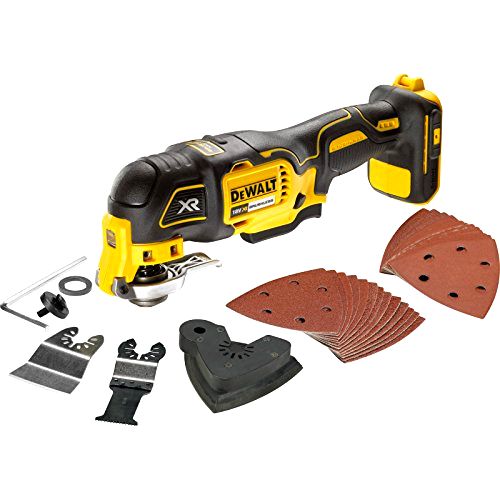
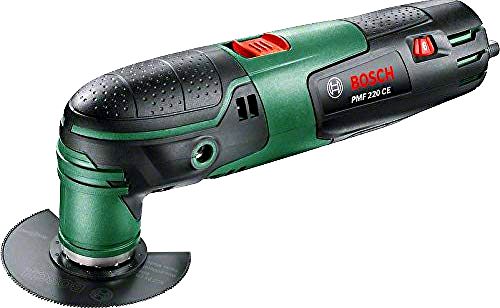
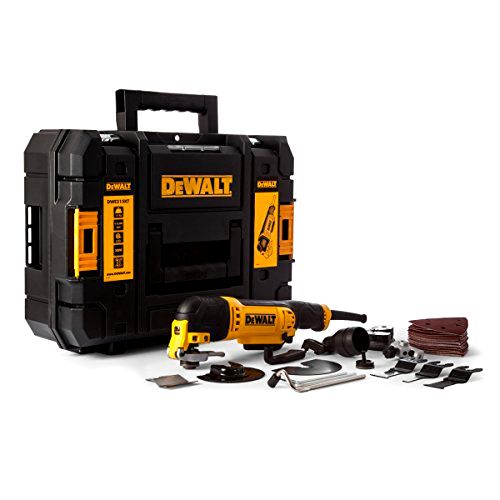
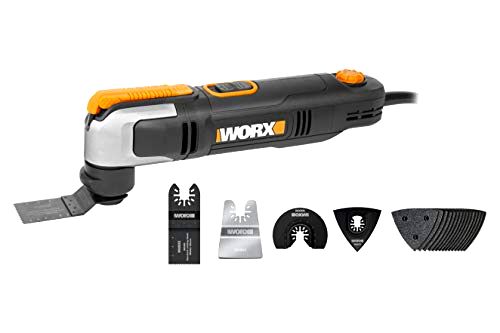
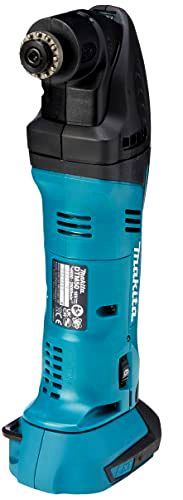
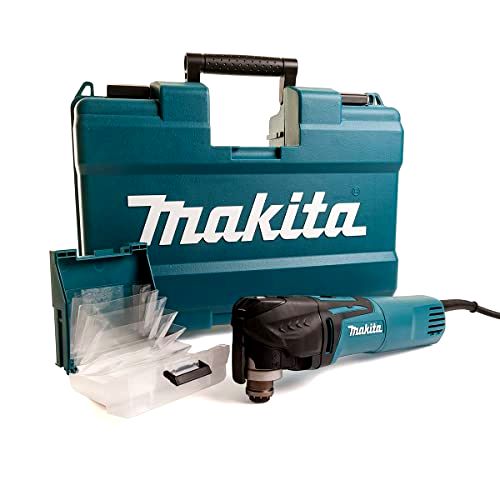
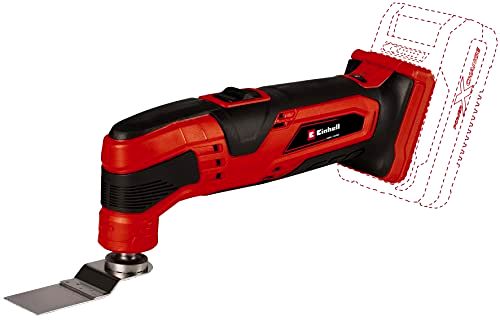
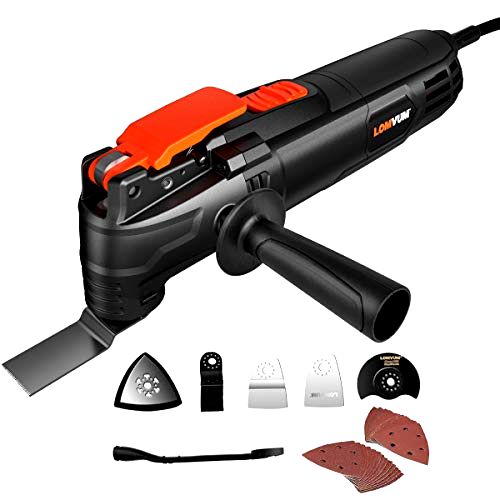
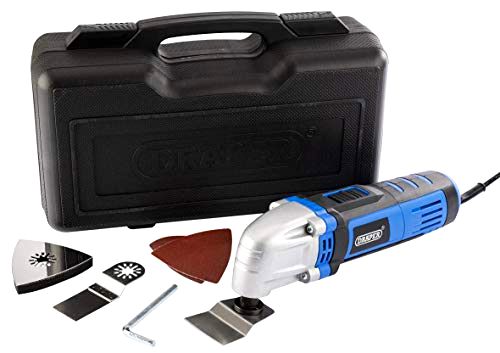

Share